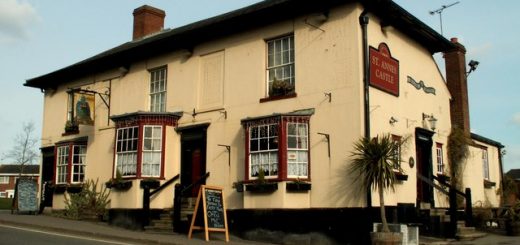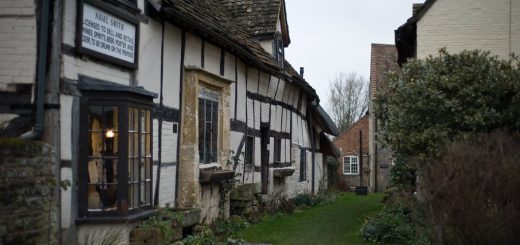Boston House
There are many locations that have and unjust reputation of being haunted and I feel this may be the case with the Boston House in Chiswick. The earliest account I have found of the haunting comes from Christina Hole’s Haunted England: A Survey of English Ghost Lore 1941.
 ‘Boston House in Chiswick is supposed to be haunted by the ghost of Lady Boston who was murdered by her husband at some unknown date. The legend runs that he suspected her of carrying on an intrigue with Lord Fairfax, whose house overlooked the garden. Discovering her one night writing an incriminating letter to her lover, he murdered her and threw her body in the Thames. It was washed up a few days later and was then secretly buried in a corner of the garden. An ivy-covered mound was long pointed out as her grave. Her ghost was said to haunt both Boston House and Fairfax House for many years afterwards, and so persistent was the legend that, according to one account, she was seen in Burlington Lane by a passing cyclist a few years ago. Unfortunately there does not seem to be any evidence that such a murder was ever committed. The house is believed to have been built by Viscount Boston who died in 1754, and to have derived its name from him. If he murdered his wife he must have done it very cleverly, for no historian of the district seems to have any knowledge of the crime. From 1740 to 1772 the house was occupied by others, and during its long history it has been used for many purposes and by many tenants. Murder is not the only cause of hauntings, and the ghost, if she exists, may not necessarily be that of a murdered person. The story of the crime as given to me was full of interesting details, but as it seems to be quite untrue, as far as my enquiries can discover, I will not burden these pages with them.’
‘Boston House in Chiswick is supposed to be haunted by the ghost of Lady Boston who was murdered by her husband at some unknown date. The legend runs that he suspected her of carrying on an intrigue with Lord Fairfax, whose house overlooked the garden. Discovering her one night writing an incriminating letter to her lover, he murdered her and threw her body in the Thames. It was washed up a few days later and was then secretly buried in a corner of the garden. An ivy-covered mound was long pointed out as her grave. Her ghost was said to haunt both Boston House and Fairfax House for many years afterwards, and so persistent was the legend that, according to one account, she was seen in Burlington Lane by a passing cyclist a few years ago. Unfortunately there does not seem to be any evidence that such a murder was ever committed. The house is believed to have been built by Viscount Boston who died in 1754, and to have derived its name from him. If he murdered his wife he must have done it very cleverly, for no historian of the district seems to have any knowledge of the crime. From 1740 to 1772 the house was occupied by others, and during its long history it has been used for many purposes and by many tenants. Murder is not the only cause of hauntings, and the ghost, if she exists, may not necessarily be that of a murdered person. The story of the crime as given to me was full of interesting details, but as it seems to be quite untrue, as far as my enquiries can discover, I will not burden these pages with them.’
Boston House can be found on Chiswick Square (which is probably the smallest Square in London) for which it acts as a kind of courtyard. The plaque on Chiswick Square reads ‘The houses each side were built about 1680, Boston House built in 1740, on the site of a previous mansion….’ Some sources however suggest Boston House was built in and then extended around 1740.
As Christina Hole stated, the house is named after Henry de Nassau, Lord d’Auverquerque, 1st Earl of Grantham, Viscount Boston, Baron Alford (born 1673 – died 5 December 1754), Lord Chamberlain to Caroline Princess of Wales. Viscount Boston married his cousin, Lady Henrietta Butler, the daughter of the Vice-Admiral Thomas Butler, 6th Earl of Ossory, Lord of the Bedchamber for King Charles II (born 8 July 1634 – died 30 July 1680) and Lady Amelia de Nassau on 12 January 1697. She was also the sister of James Butler, 2nd Duke of Ormonde (born 29 April 1665 – died 16 November 1745) who fled England following his involvement in the failed 1715 Jacobite Rebellion. Lay Henriett Butler died on 11 October 1724 and there is no evidence or suggestion that she was murdered by her husband.
According to one source Viscount Boston may not even have lived at Boston House and around 1750 he was living in his other Chiswick home, Grove Park (or House). Therefore, depending upon when Boston House was built, Lady Henrietta herself may not even have lived there, especially as she died in 1724.
Circa 1750, Boston House passed to Lord Archibald Hamilton of Riccarton and Pardovan (born 1673 – died 5 April 1754). Then to is son in law Francis Grenville, Earl of Brooke and 1st Earl of Warwick (born 10 October 1719 – died 8 July 1773). His wife Elizabeth Grenville, (nee Hamilton) died 1800.
Between 1845 and 1861 Boston House was used as a girls school run by a Mrs Nethercliff and just like Walpole House it also lays claim to being the inspiration for Miss Pinkertons Academy in Makepeace Thackeray’s novel Vanity Fair.
From 1869 Boston House was the residence of Henry Stratton Bates and then between 1889 and 1912 it became a home for inebriate women known as St Veronica’s Retreat. The building was renamed Nazerath House between 1912 and 1922 when the Sisters of Nazerath ran the retreat.
The Chiswick Polish Company bought Boston House in 1922 and used it for recreation and canteen facilities for it’s female staff. After 1972 the house was divided into four residential flats.
Haunted?
I certainly do not know of any reported haunting like experiences at Boston House and it has been inhabited constantly for the last quarter century if not longer. Although the legend of the murdered Lady Boston has no basis in fact, it is an interesting piece of our haunted heritage and the story is worth preserving. However, I wonder where the origins of the story came from. Was it a total fabrication or is it an extension of another legend?
Boston House aside, Christina Hole’s mention of an appartion being encountered by a cyclist on Burlington Lane is worth taking note of.




Recent Comments